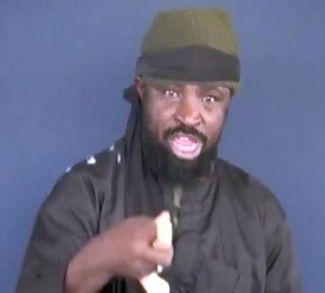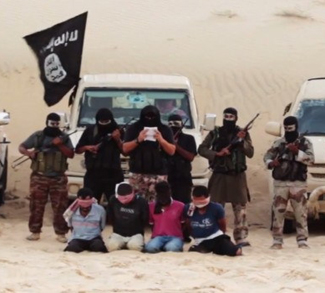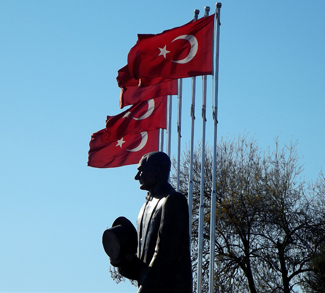Boko Haram’s brutal war against the Nigerian state is now in its sixth year. On the surface, the militant group appears to be losing the battle and significantly weakened after numerous setbacks throughout 2015. The long-running Islamist insurgency, which began in 2009 in the northeast of the country, looks to finally be on the wane: militants have recently retreated into their rural heartlands after being pushed back from the urban areas they once controlled by a regional coalition of troops from Nigeria, Cameroon, Chad and Niger.
However, whilst it is clear that the group has been temporarily weakened, the threat from Boko Haram lives on due to one particularly worrying development: its pledge of allegiance to Islamic State (ISIS). The alliance with Islamic State means that an organization which previously confined its activities to the northeast region of Nigeria will now adopt a dangerous new outlook that extends across borders and into the wider region.
Over the past six years, Boko Haram has gained a reputation as a particularly brutal terrorist group, forcefully pressing its objectives via a wave of killings, bombings, and abductions across Nigeria. It gained widespread international media coverage in April 2014, after the kidnapping of more than 200 girls from their boarding school in the town of Chibok. This thrust the situation into the international public consciousness, prompting widespread outrage and strong condemnation from Western governments. Key developments and events such as this have been widely reported, however the background context to the insurgency has often been left under-explored. Whilst the conflict in Nigeria is often simplified and presented within the overall narrative of global Islamic terrorism, in reality the background to the militancy is complex and multi-faceted, with many inter-related factors being responsible for the rise of Boko Haram and its sustained campaign against the Nigerian state.
The Evolution of Boko Haram
To better understand the insurgency, it is essential to go back to the beginning. Boko Haram was formed in 2002 by Muslim Cleric Mohammed Yusuf. Yusuf set up a religious complex consisting of a mosque and Islamic school with the initial aim of opposing Western-style education – which has been prevalent in Nigeria since the historical Sokoto Caliphate fell under British imperial control in 1903. The group set up its headquarters in the northeast city of Maiduguri, and became known by the local population as Boko Haram (loosely translated from the local Hausa language: ‘Western education is forbidden’). Officially, the group is called ‘Jama’atu Ahlis Sunna Lidda’awati wal-Jihad’, meaning ‘People committed to the Prophet’s teachings and Jihad.’
Based on its radical interpretation of Islam, Boko Haram’s aims quickly moved beyond just education and morphed into a wider political project. Its goal was to overthrow the Nigerian government and create an Islamic Caliphate, which would forbid Muslims from taking part in any political or social activity associated with Western society, such as voting in elections, wearing Western-style clothing, or receiving a secular education.
In July 2009, Boko Haram shifted its focus to full-scale militant insurgency, launching a campaign of violence in Borno state, killing hundreds of people in attacks on police stations and government buildings. The response from the Nigerian military was immediate and overwhelming: security forces launched a sustained assault, seizing the group’s headquarters, killing its leader and capturing or killing many of its fighters. At this point Boko Haram appeared to be decimated. However, its fighters soon re-grouped under a new leader, Abubakar Shekau.
Under the leadership of Shekau, recruitment soared and Boko Haram gained a notorious reputation for committing acts of horrific brutality, launching ever more ambitious attacks throughout Nigeria. In August 2011, Boko Haram extended its reach to the capital, killing 23 people in a suicide bombing at the UN headquarters in Abuja. The wave of violence continued on a daily basis – in January 2012, more than 100 civilians were killed in a single day of co-ordinated bombings and shootings in the town of Kano.
As violence escalated the government struggled to maintain control, resulting in President Goodluck Jonathan declaring a state of emergency in May 2013 in the three northern provinces of Borno, Yobe, and Adamawa. Troops were deployed to the region to combat the growing militant threat, leading to Boko Haram fighters being pushed out of their urban base Maiduguri and retreating to the dense Sambisa forest to the South, and the remote Mandara Mountains close to the border with Cameroon.
However, the insurgency proved difficult to put-down, and attacks have continued in recent years at an alarming rate. Militants have emerged from their rural hideouts to launch mass attacks on towns and villages – looting property, carrying out mass killings, abducting women and girls, and conscripting men and boys into their army. In April 2014, the group launched its most notorious attack, kidnapping more than 200 girls from a boarding school in Chibok. Despite a huge international outcry and extensive search by the Nigerian military, their whereabouts remains unknown and it is assumed that many have been kept as slaves or sold-off as wives to jihadist fighters.
In August 2014, Boko Haram announced the creation of a Caliphate in the areas under its control, establishing the town of Gwoza as its new center of power. This was followed just months later with a declaration from Boko Haram’s leader Abukakar Shekau that the group had pledged its allegiance to ISIS, and should henceforth be known as Islamic State’s ‘West Africa Province.’ Despite this development, the Nigerian military has continued to push-back the militants throughout 2015. Many Boko Haram fighters have been killed, a large quantity of weapons has been seized and hundreds of captives have been freed. However despite its apparent retreat, Boko Haram has so-far proven itself to be lethal and resilient – it still has an estimated 9,000 fighters, and has gained control of vast amounts of money and weapons. This all suggests that the insurgency is far from over.
Deconstructing Boko Haram
This timeline of events portrays a picture of a militant organization resourceful enough to overcome repeated attempts to destroy it. Considering this, a key question is posed: How was Boko Haram able to emerge as a powerful militant group with the ability to wage the sustained insurgency that has wreaked havoc in Nigeria for over six-years?
Firstly, its historical roots lie in its resistance to the West: sentiments which can be traced back to the colonial period during which Western ideas were first introduced to Nigeria. Many Muslim families in the northeast of the country have long refused to send their children to government-run ‘Western-style’ schools, suggesting that the current jihad is not simply a new phenomenon, but the latest manifestation of a history of religious rebellion in the northeast of the country. Many analysts have suggested that Boko Haram emerged from remnants of the Maitatsine movement of the 1970s-80s, which was led by radical preacher Mohammed Marwa, who denounced Western education and disregarded mainstream Muslim scholars. The group engaged in frequent violence and armed clashes which led to the deaths of thousands of people. It can be argued that Boko Haram has continued this tradition of violent rebellion in the name of opposing Western influences.
Secondly, the concept of a ‘war against the state’ is a key ideological factor behind the rise of Boko Haram. The militants have continually stated their desire to overthrow the Nigerian government and replace it with an Islamic Caliphate governed under Sharia Law. Boko Haram’s strategy to undermine the government’s authority has been clear through their choice of targets; for example the June 2011 bombing of Abuja’s Police headquarters and the August 2011 bombing of the UN building. This desire stems from a dissatisfaction with the state’s structures of governance, which the militants view as corrupt, Western-oriented and un-Islamic in nature.
Thirdly, there is a clear religious element behind the group’s aims: they have stated their ambition to establish a Caliphate, and have implemented their version of Sharia Law in areas under their control. However, there is evidence to suggest that the majority of Nigeria’s Muslim population does not support the activities of Boko Haram. Prominent Muslim figures have spoken out against the group, whilst the Nigerian Coalition of Muslim Clerics has publicly denounced it as well. So rather than being inspired by a purely faith-based version of Islam, Boko Haram can be said to have manipulated the religion, using faith as a vehicle through which to pursue its political agenda, mainly the overthrow of the state to establish control of its territory.
Fourth, as with the emergence of almost all militant groups throughout history, there are strong economic factors which have played a key role in creating the conditions for Boko Haram to emerge and thrive. It can be viewed as an uprising not just located within religion and geography, but also within the wider context of poverty and economic underdevelopment. Similar with many other countries in Africa, particularly those with natural resources such as oil, economic growth has been accompanied by growing inequality. In this sense, Nigeria can be understood to be suffering from the ‘Resource Curse’ – a situation in which oil wealth creates corrupt governance, resulting in vast inequalities between regions and social groups, increasing the risk of poverty-induced conflict. Nigeria is now Africa’s largest economy, yet it’s also one of the continent’s most unequal societies. In the north, 72% of the population live in poverty, compared to just 27% in the south and 35% in the Niger Delta.
Some may contend that this combination of poverty, joblessness, and despair at the perceived corruption of the central government have created fertile ground for the northeast’s generation of disenchanted young men to turn to militancy. This, along with the use of religion by Boko Haram as a vehicle for mobilization, is a key reason behind the insurgency.
Lastly, the role of climate change can’t be ignored. It is an increasingly important factor in conflicts around the world, and has been leading to a growing instability in Nigeria for decades. A 2009 study by the UK Department for International Development warned that climate change could result in desertification in the region, causing water shortages and crop failures. A more recent study by the US Institute for Peace found a ‘basic causal mechanism’ linking climate change to violence in Nigeria. Poor adaptive responses to climate change can result in severe secondary effects such as hunger, unemployment, and the loss of livelihoods, creating an atmosphere of social dislocation from which violent conflict can emerge. A report by Africa Review suggested that many of Boko Haram’s fighters are people displaced from neighboring Chad and Niger as a result of severe drought and food shortages, some of who fled across the the border only to be lured in by Boko Haram’s alternative ideology.
The Lingering Threat of Boko Haram
In light of the factors behind Boko Haram’s rise and continuing appeal, does the group present an existential threat to Nigeria? Some may argue that it does, suggesting that it remains an attractive proposition to young marginalized people, offering an alternative political order. However, in reality the group has so far been largely contained in the far northeast of the country, as the Nigerian military has been increasingly effective in pushing back the militants, whilst the vast majority of Nigerian citizens reject Boko Haram’s extremist ideology.
New Nigerian President Muhammadu Buhari, elected in May 2015, recognizes that the current threat has not gone away, telling the UN General Assembly in September 2015 that terrorism is the ‘’immediate problem’’ which the country must face.
Overall, the toll of the conflict has been devastating: almost 43,000 people are estimated to have been killed since May 2011, whilst 1.2 million people have been internally displaced. Despite recent setbacks, Boko Haram has continued to pose a huge threat to civilians. According to Amnesty International, at least 3,500 civilians were killed by the group in the first 10 months of 2015, with over 2,000 massacred in the town of Baga alone.
Boko Haram’s recent pledge of allegiance to Islamic State is a cause for severe concern, not just for the Nigerian Government, but also for the wider region. It could yet prove to be a significant recruiting tool for Boko Haram’s leaders to revive the organization once more – this time with a new ideology and an extended mandate, to look beyond Nigeria’s borders and into the neighboring countries of Cameroon, Chad, and Niger. This previously localized conflict is already showing worrying signs of change, as Boko Haram has shifted its tactics and staged numerous attacks in Chad and Cameroon, claiming at least 520 lives.
Given the complex factors which lie behind the emergence of Boko Haram, it is unlikely to be defeated through a military solution alone. If the underlying conditions remain unchanged, then the militancy is likely to lie dormant under the surface, only to re-emerge in another form. Therefore a multi-faceted long-term strategy is needed, one which also addresses the ideological, environmental, and economic causes of the insurgency.




